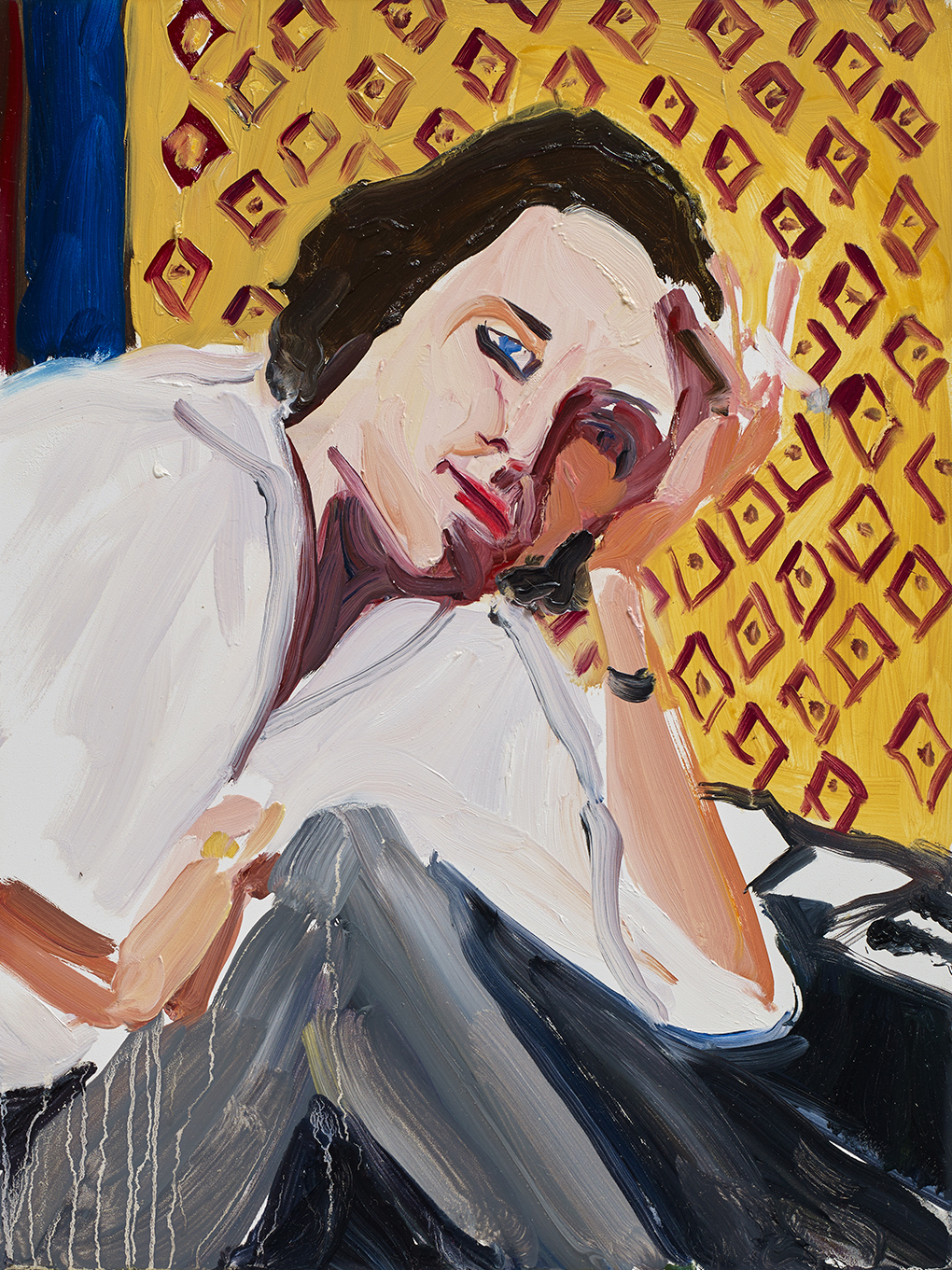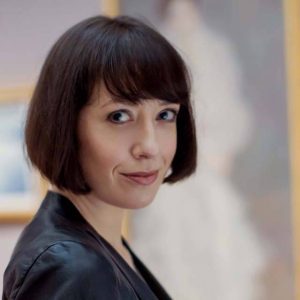BY GEMMA BLACKSHAW
Linda, you are leaving
your old body now.
It lies flat, an old butterfly,
all arm, all leg, all wing,
loose as an old dress.
I reach out toward it
but my fingers turn to cankers
and I am motherwarm and used,
just as your childhood is used.
(Anne Sexton, ‘Mother and Daughter’)
When I asked, in 2015, how she might describe the images of mothers, daughters and poets that have preoccupied her, the artist Chantal Joffe talked of transitions – of ageing, and of painting as an attempt to mark the moments in a lifetime that are both intensely personal and reassuringly universal.
Esme, her daughter, has just started secondary school; in the portraits she returns her mother’s gaze with a new boredom and suspicion, arms folded across her chest. Skirts, striped t-shirts and pointed shoes cover a body the artist is no longer permitted to depict, a loss of innocence and intimacy that is counted out in the piles of family photographs that cover Joffe’s studio surfaces – Esme by a paddling pool; leaning over a birthday cake; sucking on a straw.
In her poem ‘Mother and Daughter’, Anne Sexton (1928-74) addressed the eldest of her two girls, Linda, who had just turned eighteen, leaving her ‘old body’ (‘all arm, all leg, all wing’), her childhood and mother behind. Ignored, rebuffed, ‘pick-pocketed’ – Sexton reflects on the transition in their relationship, on what she has given and what she has lost.
Joffe’s interest in the confessional poetry of Sexton, her friend Sylvia Plath (1932-63), and their tutor at Boston University, Robert Lowell (1917-77), stretches back to her time as a student, but in recent months it has deepened. Painting at a time of change – on the brink of her daughter’s teenage years – she has returned to this literature of confidences, experiencing its often-painful descriptions of familial relationships anew.
Her most recent exhibition at the Victoria Miro Gallery, London (January-March 2016), included the portraits of Esme, her cousins and friends that have become, over the years, so much a part of Joffe’s practice – their ageing a marker of her development as a painter.
But these images appear alongside those of the American poets and their families: Anne Sexton embracing
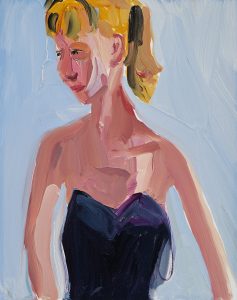
Sylvia at the Beach, 2015
Oil on board
35.5 x 28 cm
14 x 11 1/8 in
Courtesy the Artist and Victoria Miro, London (Photography Stephen White)
© Chantal Joffe
Linda; Robert Lowell with his wife, the writer Elizabeth Hardwick and their daughter, Harriet; Sylvia Plath, radiant at the side of Ted Hughes. In conversation, Joffe refers to these subjects by their first names – ‘Look at Anne with her cigarette; Sylvia – so happy…’ – and this reveals not only the intensity of her reading but also the intimacy of her relationship with people she has never met and will never know.
In early 2015, in an interview with Sarah Howgate, Contemporary Curator at the National Portrait Gallery, London, Joffe described how, as a student at the Royal College of Art (from 1992-94), ‘I was always trying to inhabit other people, particularly other artists… I love them so much I want to be them.’
In a series of collages dating from this period, she painted images of the female poets she had come to love: Plath at the beach, beaming in a white bathing suit; Sexton preparing for her suicide, locked in the car in her mother’s fur coat. Painting her own features over theirs, or sticking a closely cut photograph of her head and shoulders on to their heads and shoulders, Joffe represented both her identification with these writers and her determination to overcome the personal and professional conflicts they experienced – significantly, in the image of the suicidal Sexton, Joffe presents (as she wrote to me in an email interview) her ‘cheerful, young face’, smiling from ear to ear.
In her new images of these women, Joffe is more concerned with empathy than identification. Understanding the indivisibility of these poets’ lives and works through her own history as an artist, mother and lover, Joffe’s recent paintings of Plath and Sexton are both more nuanced and more knowing. Working from family photographs reproduced in their biographies, collections of letters and verse, she paints their portraits without the need to include her own image, to ‘inhabit’.
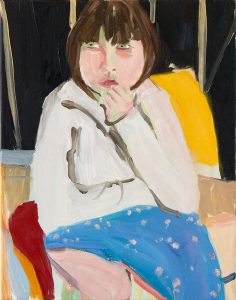
Esme in the Beach Hut, 2015
Oil on canvas
45.8 x 36 x 2.5 cm
18 1/8 x 14 1/8 x 1 in
Courtesy the Artist and Victoria Miro, London (Photography Robert Glowacki)
© Chantal Joffe
But her life merges with their lives, nevertheless, with her self-portraits, her paintings of Esme, their family and friends surrounding her images of the poets. As she moves back and forth between photographs and canvases – between images of families that include her own – her very practice becomes bound up with her representation of shared emotion and experience, across the 20th and 21st centuries.
The relationship of Joffe’s paintings to the photographs they re-represent is more complex than it might at first appear. The unposed, unplanned pictures that interest her – of families, children, and seemingly inconsequential scenes of domestic life – are, in her own words, the images that enable her to achieve through the act of painting ‘a distillation of the everyday’.
Joffe may paint quickly, but the working of oil on canvas is a much slower process than the pressing of a button on a camera and it is in these delays – these movements from the easel to the glass table top she mixes her pigment upon, these returns to the canvas – that she ‘distils’. Working both reflexively and critically, Joffe’s painting of the photograph is fundamentally different to the photograph itself: she colours and erases, extracts and distorts. Paint diluted with thinners runs down the canvas surface; primed in lurid green, violet, electric pink, this vivid ground grins through flesh tones painted with broad, bold sweeps of the brush.
Joffe’s mark-making draws attention to both the materiality of the paint and the physicality of her engagement with it; she stands to work, crosses the studio floor, her arms moving expansively and this ‘dance’, as she describes it, is registered on the surface itself. Photographs, she remarks, are ‘all over’ – everything is reproduced in equal, often excessive detail – but in her gestural approach to painting, in what she purposefully omits, Joffe leaves a great deal to the viewer’s imagination.
What do we imagine as we look at a portrait of a slender woman in a black dress, eyes downcast? We are unlikely to recall the photograph of Sylvia Plath it is inspired by, of the poet in a rowing boat, arms resting on a pair of oars, the straps of her sundress dangling under her shoulders – details that Joffe has almost entirely obliterated.
Untraceable, unidentifiable, we might wonder instead about this woman’s relationship with Joffe, imagining her as a sister, a niece, a friend. The work of the confessional poets, which takes human emotion, sincerity and vulnerability as its ultimate subject, frames Joffe’s practice.
But in this new body of work we see Joffe’s confessional painting framing the practice of the poets she has admired for so long. Portraiture, for Joffe, is an analogy for family – a family that extends to those artists one loves.
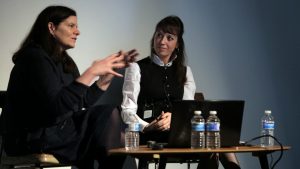
This research was first published in the catalogue accompanying the exhibition Chantal Joffe at Victoria Miro, London (January-March 2016).
About the Author:
Dr Gemma Blackshaw is Professor of Art History at Plymouth University. In 2014 she co-curated with artist David Austen Drawing Room’s most-attended exhibition, The Nakeds, which included new work by Chantal Joffe. Blackshaw and Joffe have been ‘in conversation’ ever since, most recently at the Zabludowicz Collection, London, where they presented a ‘Master Class’ (2 February, 2017). Speaking to close to 200 people, the largest audience the Zabludowicz had attracted since its founding in 2007, they talked about Joffe’s transformation of the modernist tradition of painting, portraiture, and that most-contested genre of Fine Art, the nude. Their conversation is available at: https://vimeo.com/203418830

